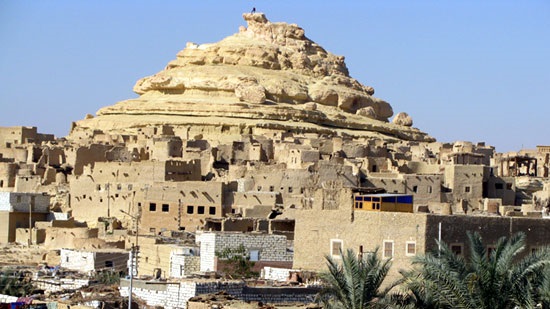I would never have believed that after travelling more than 300 kilometres through the desert—from Marsa Matrouh, where we spent one night on our journey from Cairo—I would find such a rich culture in Siwa.
Some 270,000 people—belonging to eleven tribes, ruled by 12 Sheikhs—live in Siwa. Siwans have lived in this remote and isolated area for hundreds of years, which is why they tend to have their own traditions.
They speak Berber or Amazigh—an unwritten language shared by other tribes in North Africa, to which Siwans bring a unique accent. Arabic, however, is spoken and used in public education.
Siwans wear different clothes; ladies don exquisitely embroidered dresses, especially in weddings. The younger the lady, the more decoration she adopts in her dress.
The oasis is rich in craft traditions like pottery, baskets and jewelry. They use five main colours in their crafts: red, green, orange, yellow and black, which symbolise the fruit of the date tree at different stages of maturity.
Siwans depend on dates and olives for their livelihood. Huge patches of palm and olive trees are everywhere in Siwa. They use both in various ways, from decorating their houses with palm to making furniture with the trunks of olive trees and making date jam and paste, pickled olives and, strangely enough, olive jam, which tastes surprisingly pleasant.
Special Siwa dishes include tagella enteeny and enkota, both made with dates and olive oil, of course.
Education is very important for Siwans, including girls who are allowed to attend university if they want. Illiteracy among youth ages 15 to 35 does not exceed 5%.
"Siwa is a Utopia –nearly, which has a very special way of life. We don’t have a court. The tribal rules govern us. Social support in weddings and funerals is another rule that governs us. Perhaps the union feast is the best example for that," relayed Omran Jeery, our trip guide.
Union celebration, or “the feast of peace”
“The Dakrour Mountain union celebration commemorated the unity of east and west Siwa after decades of feudal fighting over land and water. Nowadays, they gather every year in the mountain to share a meal of fatta, sing, dance and pray," said Ahmed, a minibus driver.
Dakrour Mountain witnesses the unity celebration or the 'feast of peace' on three full-moon nights either in October or November. This year’s celebration was held in October.
The day before the feast, tens of men go to Dakrour Mountain to prepare for the feast. All houses deliver their share of traditional dry bread -megardal- to the mountain. On the first day, everyone prepares their three day accommodation of palm tree huts; many animals are slaughtered including two or three camels. The meat is cut and cooked with rice and pieces of bread and served on large traditional platters.
Men and unmarried women are allowed to attend the festival. Girls must go home before dawn and men can sleepover in the Dakrour area. Married women are not allowed to participate but they gather in their houses and share a meal as well.
"It is also a chance for young women and men to see each other and choose their future spouses," said Jeery.
Besides, he added, Sufi religious rituals and prayers continue day and night throughout the three days.
The Fortress of Shali
The 12th-centry Fortress of Shali is built from karshif, the local soil which is made up of salt, fine sand and clay and is made hard by water and the sun.
Shali is the name the inhabitants of Siwa gave to their town.
In historical times, Siwans used to hide from their enemies inside the fortress's tunnels, and would use the well inside the fortress to drink from. The well is still there today, but it is nearly dry.
While the sun made the karshif stronger, rain has a negative effect on it. The heavy rain caused a partial destruction of the fortress in 1928 and forced its inhabitants to abandon it.
Al-Masjid Al-Ateek, or the fortress mosque, was built 500 years ago and is still used for prayers nowadays. Special places for ablution were built inside the fortress.




